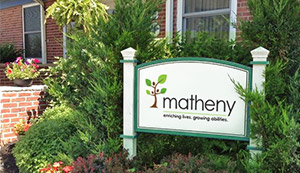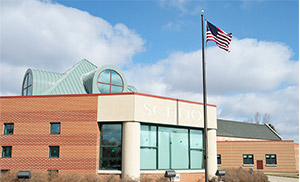Posted on July 8, 2014 by Matheny

Teaching assistant Glenn Wey and student Shane Szott.
In what has become an annual tradition, Matheny closed off its front parking lot on Friday, June 20, and converted it into several adapted basketball courts so Matheny students could compete in games designed to raise money for the American Heart Association as part of the AHA’s Hoops for Heart program. The idea was to raise awareness of cardiovascular disease among women and to encourage women to reduce their risks. The day was a success, as $370 was raised from Matheny staff members, friends and families.
Matheny’s adapted physical education program promotes fitness by modifying traditional sports such as basketball to encourage students to create their own independent movements. In addition to basketball, adapted sports include soccer, bowling, football and many others.

Lori Bertoline, regional director, youth market, American Heart Association, standing second from right, visited Matheny to thank everyone for their support and to receive the funds raised through Hoops for Heart. Also standing, from left, Matheny School curriculum supervisor Jim Hintenach, speech-language pathologist Emily Teed and physical therapy aide Meghan Hoskins. Front row, from left, Matheny students Sara Hoffman, Vraj Desai and Mary Rita Tortorello.
Posted on November 20, 2013 by Matheny

Sean Bielefeldt, Matheny director of recreation therapy, explains an adapted sports activity to a student visiting the Matheny School exhibit at the NJEA convention.
Visitors to the Matheny exhibit at the recent New Jersey Education Association (NJEA) convention in Atlantic City had an opportunity to experience first-hand what it’s like for children with disabilities to participate in a game or sport. Matheny staff members designed a beanbag toss and invited convention attendees to try it out while sitting in a wheelchair. In addition, the participants had to limit the mobility of their arms or eliminate use of their arms altogether. Or they had to cover one or both eyes.
“I think many people walked away with more appreciation for students with special needs,” said Cindy LaBar, Matheny’s director of physical therapy. “It also helped them to understand that our students and all people with physical disabilities are able to participate in activities just like they do, with some adaptations. We explained that our students can ride a bike, go for a walk and even throw a football. There seemed to be a great deal of interest among public school teachers and therapists about how we adapt physical activities.”
The NJEA convention attracts thousands of educators from throughout the state who are looking for high-quality professional development and the latest in educational technology.






